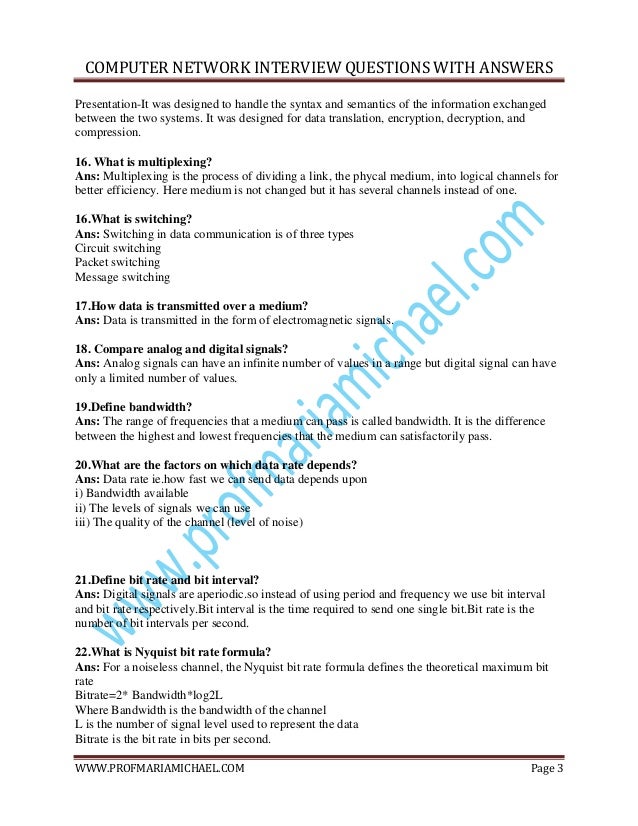Unknown Facts About "Networking Troubleshooting: Your Ultimate Interview Question Guide"

Networking Troubleshooting 101: Essential Interview Questions and Tips
Networking troubleshooting is a vital skill for any sort of IT expert. Whether you're using for a system task or only really want to comb up on your understanding, understanding the vital job interview concerns and suggestions may help you stand out coming from the competitors. In this message, we'll discover some of the common networking troubleshooting questions that you might encounter in an job interview, as effectively as useful suggestions to make sure your success.

1. What is the OSI version, and why is it significant in networking troubleshooting?
The OSI (Open Systems Interconnection) design is a visionary platform that systematizes the feature of a communication system in to seven unique coatings. These levels include physical, record hyperlink, network, transportation, session, presentation, and function.
Understanding the OSI style is vital in network troubleshooting because it delivers a structured technique to identifying and addressing problems. By determining which coating of the OSI design is affected through a concern, network administrators can easily tighten down their focus and swiftly separate potential trigger.
2. How would you troubleshoot a slow-moving net relationship?
A sluggish world wide web link may be triggered through several variables such as bandwidth restrictions or network blockage. To address this problem properly:
- Examine if other devices on the very same network are experiencing identical concerns.
- Validate if the router or cable box firmware is up to day.
- I Found This Interesting or solutions to identify if it's specific to one web site.
- Work velocity tests using internet devices like Ookla Speedtest.
- Take into consideration talking to your World wide web Service Provider (ISP) for help.
3. Describe DHCP (Compelling Host Configuration Protocol) and its job in system troubleshooting.
DHCP is a protocol that instantly appoints IP addresses to devices connected to a system. It streamlines system management by dealing with hands-on IP address arrangement.
In system troubleshooting situations entailing DHCP issues:
- Confirm that DHCP server(s) are active and reachable.
- Check for opposing IP address projects within the DHCP extent.
- Make sure the DHCP web server has enough on call IP addresses to offer tools.
- Examine if there are any network connection complications protecting against units from arriving at the DHCP server.
4. What are some popular trigger of system blackouts?
Network interruptions can happen due to a range of causes. Some common trigger feature:
- Components failures, such as switches, routers, or network interface memory cards (NICs).
- Electrical power failures or power rise that affect networking tools.
- Software program bugs or misconfigurations that interrupt network solutions.
- Individual error, like unintended cable interferences or wrong configurations.
- Network attacks, such as Circulated Denial of Service (DDoS) attacks.
5. How would you troubleshoot an issue along with a details gadget incapable to link to a system?
When repairing a unit connection problem:
- Check out bodily connections and cables for any type of damage or loosened hookups.
- Validate if the gadget has the appropriate IP address configuration (fixed vs. powerful).
- Verify if the device is making use of the correct subnet cover-up and nonpayment portal environments.
- Exam connection through sounding various other devices on the same network sector.
- Consider checking firewall setups or safety policies that may be blocking out get access to.
System Troubleshooting Tips:
1. Record everything: Maintain in-depth files of your troubleshooting measures, featuring any improvements helped make along the way. This documentation can easily assist you pinpoint designs and track your progress.
2. Utilize diagnostic devices: Leverage a variety of networking resources like ping, traceroute, netstat, and Wireshark to collect information and identify concerns successfully.
3. Recognize methods: Familiarize yourself along with frequently utilized process like TCP/IP, DNS, DHCP, and SNMP. Knowing how these procedures operate will definitely help in addressing cases involving them.
4. Stay up-to-date: System technologies are frequently growing. Keep present by reading sector magazines and joining pertinent instruction treatments to boost your troubleshooting skill-sets.
Final thought:
Networking troubleshooting is an essential skill for IT professionals, and being well-prepared for an job interview may considerably strengthen your possibilities of excellence. By understanding the OSI model, DHCP, usual system issues, and carrying out effective troubleshooting approaches, you may illustrate your competence and stand up out coming from various other applicants. Always remember to chronicle your measures, use proper diagnostic resources, and stay upgraded along with the most recent networking technologies to excel in this field.
